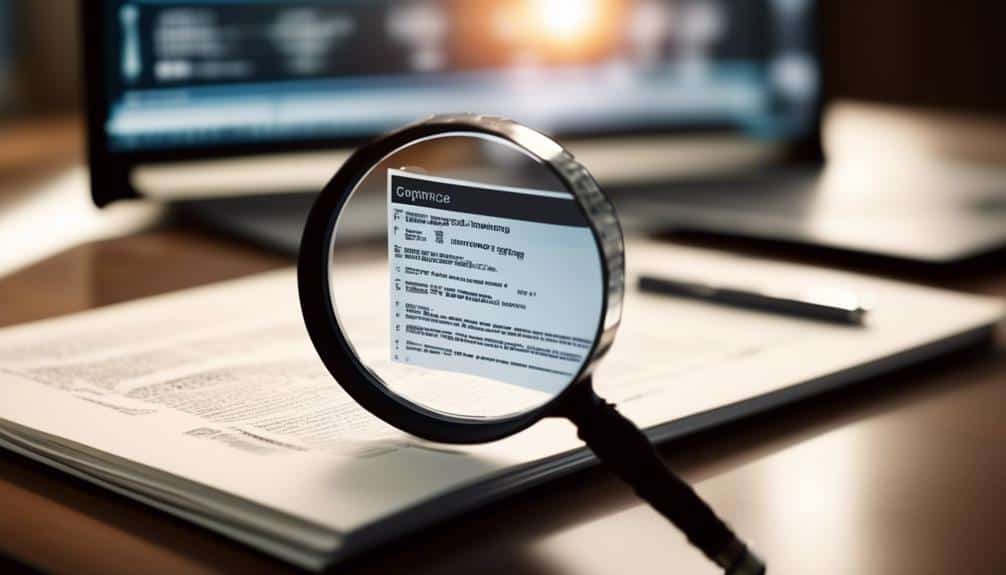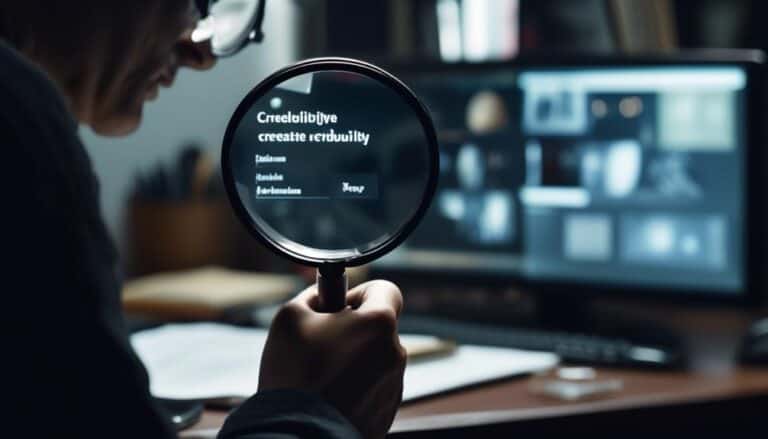The Trust Factor: How to Find and Verify Credible Sources for Your Content
Ever wondered how to discern between trustworthy sources and those that may lead you astray in the vast sea of information available online?
The digital age has made it easier than ever to access a wealth of knowledge, but with this convenience comes the challenge of separating fact from fiction.
As you navigate the landscape of information, it becomes essential to hone your skills in identifying and verifying credible sources to ensure the integrity of your content.
Key Takeaways
- Author credentials and expertise play a significant role in evaluating source authority.
- Cross-referencing data with multiple sources is crucial for verifying information accuracy.
- Utilizing fact-checking tools enhances content credibility and helps combat misinformation.
- Prioritizing peer-reviewed research articles ensures access to high-quality and trustworthy information.
Importance of Credible Sources

Ensuring that you rely on credible sources is paramount to establishing the validity and reliability of your information. Source credibility is essential in today's digital age, where misinformation spreads rapidly. By utilizing sound research methods, you can sift through the vast sea of information to find trustworthy sources. Research methods such as cross-referencing, peer-reviewed studies, and expert opinions can help you determine the credibility of the information you encounter.
Trustworthy information is the foundation of any well-informed decision or conclusion. Without it, the integrity of your data is compromised, leading to potentially flawed outcomes. In a world where data integrity is key, being able to discern credible sources from dubious ones is a valuable skill. Whether you're a student conducting research or a professional seeking accurate information, the ability to identify and rely on credible sources will set you apart in a sea of information overload. Remember, the quality of your information directly impacts the quality of your work.
Evaluating Source Authority
To assess the authority of a source, examine the author's credentials and expertise in the subject matter. When evaluating source credibility, it's crucial to look for indicators that demonstrate the author's qualifications to speak on the topic. Check if the author holds relevant degrees, certifications, or has a professional background in the field. Additionally, consider their experience working in the subject area and whether they've published other reputable works.
Furthermore, assessing the trustworthiness of a source involves looking beyond the author to the publication or platform where the information is shared. Consider the reputation of the website, journal, or organization publishing the content. High-quality sources typically have editorial processes in place to ensure accuracy and reliability.
In your quest for credible sources, prioritize those that have a track record of providing accurate and well-researched information. By conducting a thorough trustworthiness assessment of both the author and the publication, you can make more informed decisions about the reliability of the content you encounter.
Fact-Checking Strategies

Fact-checking is an essential process in verifying the accuracy of information before incorporating it into your work or sharing it with others. When fact-checking, focus on source credibility and misinformation detection.
Start by evaluating the trustworthiness of the sources you're using. Look for reputable websites, peer-reviewed articles, or experts to ensure reliability. Conduct a thorough assessment of the content, checking for bias that could influence accuracy.
Cross-reference data with multiple sources to validate claims and ensure consistency across platforms. Utilize fact-checking tools and websites to verify information. These strategies strengthen the credibility of your content and combat misinformation.
Peer-Reviewed Research
When evaluating peer-reviewed research, focus on reliable academic sources that have undergone rigorous scholarly evaluation. Verify the credentials of the authors to ensure their expertise in the subject matter.
This process ensures that you're accessing high-quality and credible information for your research needs.
Reliable Academic Sources
Ensuring the credibility of your academic sources is paramount when conducting research, particularly through the rigorous process of peer-reviewed research.
When delving into reliable academic sources, two critical aspects to consider are citation formatting and plagiarism detection. Citation formatting ensures that you give credit where it's due and follow academic conventions, while plagiarism detection tools help maintain the integrity of your work.
Additionally, evaluating source reliability and data credibility is key. Peer-reviewed research articles undergo scrutiny by experts in the field, enhancing the trustworthiness of the information presented.
Rigorous Scholarly Evaluation
To solidify the credibility of your academic work, it is imperative to subject your research to rigorous scholarly evaluation, notably through peer-reviewed research processes. Critical analysis and maintaining scholarly integrity are key components in this evaluation. When conducting critical analysis, you must carefully assess the quality of the sources you are referencing, ensuring they have undergone a thorough peer-review process. Peer-reviewed research articles are scrutinized by experts in the field, guaranteeing a high standard of quality and reliability. By incorporating peer-reviewed sources into your work, you demonstrate a commitment to academic excellence and integrity. Below is a table illustrating the importance of critical analysis and scholarly integrity in the research process:
| Critical Analysis | Scholarly Integrity |
|---|---|
| Ensures quality | Demonstrates commitment |
| Validates research | Upholds academic standards |
Author Credentials Verification
Verifying the credentials of authors in peer-reviewed research is essential for ensuring the reliability and credibility of academic sources. When evaluating the trustworthiness of a source, focus on source validation and expertise verification.
Begin by confirming the author's background and qualifications. Look for information about their educational achievements, professional experience, and any affiliations with reputable institutions. Check if the author has published similar research in respected journals or has received awards in their field. This process helps establish the author's expertise and credibility in the subject matter.
Identifying Bias
Identifying bias in sources is crucial for evaluating the credibility of information. Recognizing bias involves understanding that individuals' perspectives can influence the way information is presented. When detecting bias, consider the language used, the sources cited, and the overall tone of the content. Biases can stem from various factors such as personal beliefs, cultural background, or financial interests. It's essential to be aware of these potential biases to ensure that you're getting a well-rounded view of the topic at hand.
To identify bias effectively, try to look for any signs of partiality or one-sidedness in the information provided. Consider the author's affiliations, the publication's reputation, and any possible conflicts of interest. By critically analyzing the content for potential biases, you can make more informed decisions about the credibility of the source. Remember, being vigilant about bias is key to maintaining the integrity of the information you consume and share.
Cross-Referencing Information

When cross-referencing information, make sure to check multiple sources to confirm the accuracy and reliability of the data you're gathering.
It's crucial to verify the information through various reputable sources to ensure its credibility.
Always look for supporting evidence that aligns with the main points to strengthen the validity of your findings.
Check Multiple Sources
To ensure the accuracy of information, consistently cross-reference details from multiple reliable sources. By checking multiple sources, you can verify the credibility of the information you are using and mitigate the risk of spreading misinformation. When fact-checking, consider the reliability of each source and look for consensus among them to confirm the accuracy of the information. Here is a table to help you understand the importance of checking multiple sources:
| Benefits of Checking Multiple Sources | Emotional Impact | Action |
|---|---|---|
| Ensures accuracy | Feeling of security | Verify information thoroughly |
| Reduces misinformation | Peace of mind | Share verified content |
| Builds credibility | Confidence | Cross-reference consistently |
| Enhances trust | Reassurance | Uphold reliability standards |
Verify Accuracy and Reliability
Cross-referencing information from multiple credible sources is essential to verify the accuracy and reliability of the details you're relying on for accuracy. When fact-checking and evaluating sources, consider the following:
- Consistency: Look for consistency in information across various sources.
- Expertise: Verify the expertise and credentials of the authors or organizations providing the information.
- Timeliness: Ensure that the information is up to date and relevant to your topic.
- Corroboration: Seek out corroborating evidence or data to support the claims made.
- Bias: Be mindful of potential biases in the sources and strive to gather information from diverse perspectives for a well-rounded understanding.
Look for Supporting Evidence
Verifying the accuracy and reliability of information from multiple credible sources lays the foundation for the next step: looking for supporting evidence through cross-referencing. When conducting research verification, it's crucial to analyze evidence from various angles to ensure its credibility. Cross-referencing information involves comparing details, quotes, statistics, or findings across different reputable sources to validate their consistency and accuracy. By incorporating this evidence analysis technique, you can strengthen the trustworthiness of your content and provide readers with well-supported information. Below is a table illustrating the process of cross-referencing for a better understanding:
| Cross-Referencing Steps | Description |
|---|---|
| 1. Identify Information | Select key points or claims to cross-reference. |
| 2. Locate Alternative Sources | Find diverse sources with similar information. |
| 3. Compare Details | Analyze similarities and differences in data. |
| 4. Check Source Credibility | Verify the reliability of each source. |
| 5. Synthesize Findings | Compile consistent information for robust content. |
Frequently Asked Questions
How Can I Ensure That My Sources Are up to Date and Relevant for My Content?
To ensure your sources are up to date and relevant, stay informed on current trends. Use reliable research methods to verify source credibility. Confirm content accuracy by cross-checking multiple reputable sources before incorporating them into your work.
What Are Some Common Red Flags to Look Out for When Evaluating the Authority of a Source?
When evaluating sources, watch for red flags like lack of citations, bias, or outdated information. Use critical thinking to spot credibility markers such as expertise, peer reviews, and reputable affiliations to ensure trustworthy content.
Are There Any Specific Fact-Checking Tools or Resources That Are Recommended for Verifying Information?
When fact-checking content, utilize researchgate for citation analysis. Cross check data with reliable fact checking software to ensure accuracy. These tools can enhance your verification process and boost the credibility of your information.
How Can I Determine if a Research Study Has Been Peer-Reviewed and Is Considered Reliable?
To determine if a research study is peer-reviewed and reliable, look for journals with rigorous peer review processes. Check for indicators like author qualifications, methodology transparency, and citations from reputable sources. These aspects signal credibility and trustworthiness.
What Are Some Strategies for Identifying Subtle Biases in Sources That May Affect the Credibility of My Content?
When evaluating sources, look for subtle biases that could impact credibility. Pay attention to language tone, selective information, and potential conflicts of interest. Scrutinize for hidden agendas to ensure the accuracy of your content.
Conclusion
When creating content, remember that finding and verifying credible sources is crucial for establishing trust with your audience. By evaluating source authority, fact-checking information, and identifying bias, you can ensure that your content is accurate and reliable.
Utilizing peer-reviewed research and cross-referencing information will further strengthen the credibility of your work. Remember, the trust factor is key in producing high-quality and trustworthy content.








